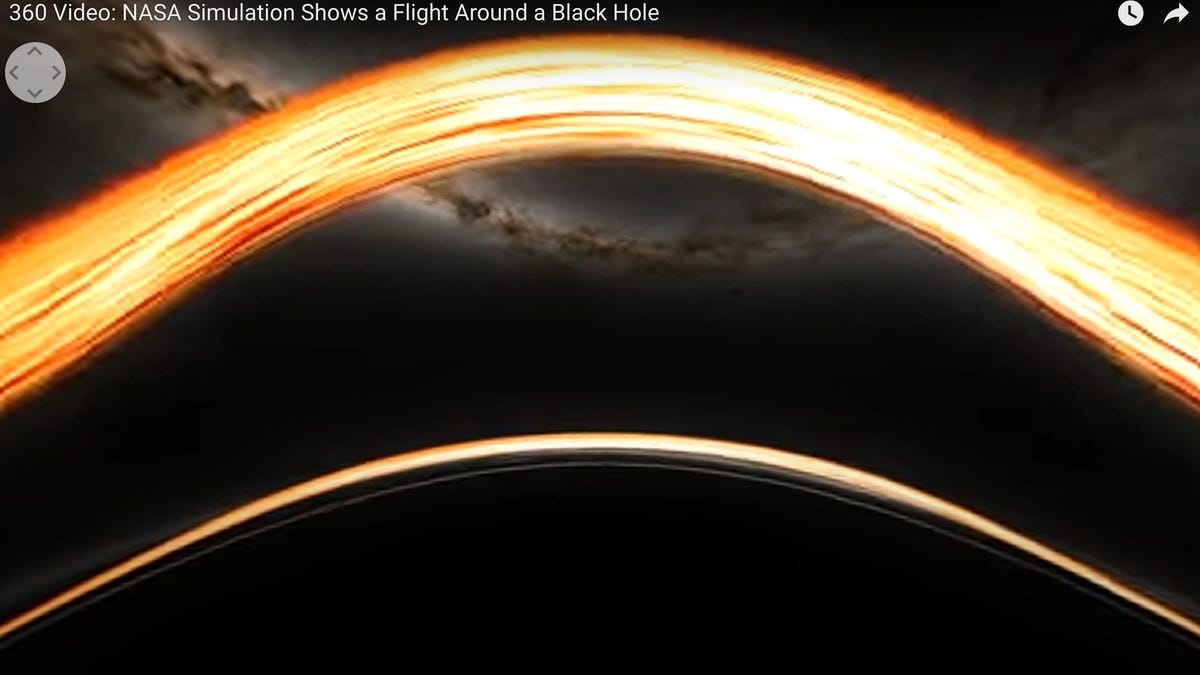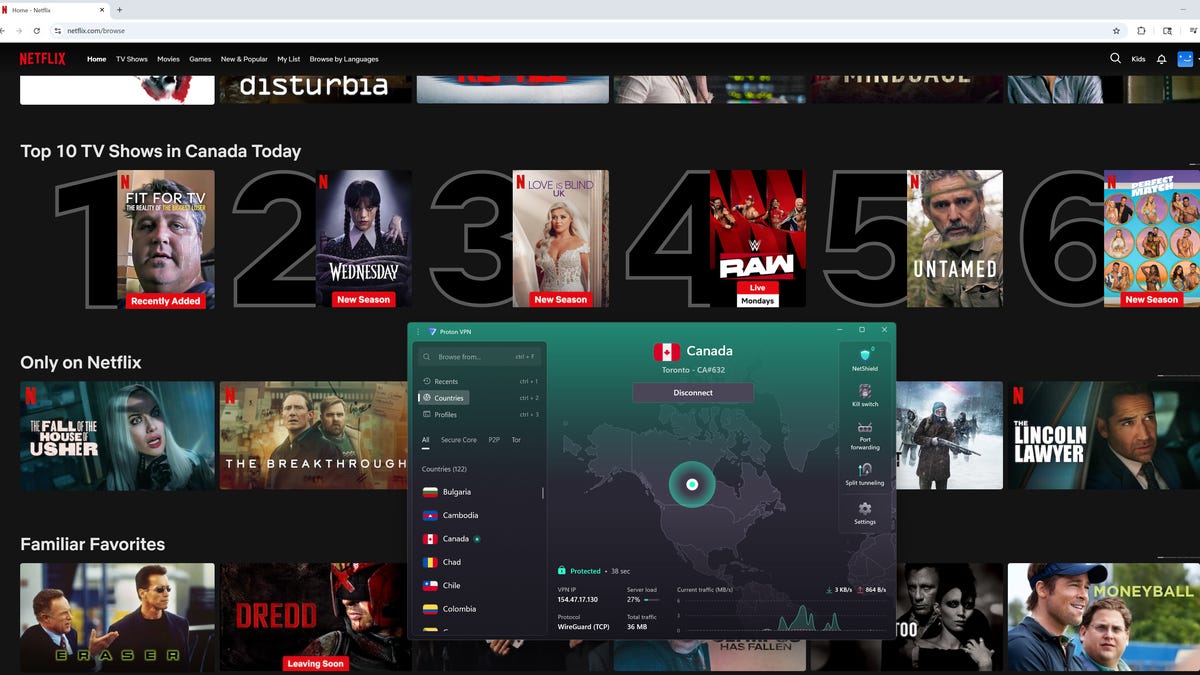Technologies
Plunge Across a Black Hole’s Event Horizon Courtesy of New NASA Video
The clip was made over five days using NASA’s Discover supercomputer.

Black holes, those mysterious places in space where gravity is so strong that not even light can escape, make for great movie plot twists. But Hollywood aside, there are many things humans don’t understand about a black hole. A new video from NASA attempts to show what it looks like when an object crosses the event horizon, or boundary, of a black hole. Since no technology can survive this experience, this might be as close as we’re ever going to get.
The video, created by NASA’s Jeremy Schnittman and Brian Powell, begins with a camera view floating toward a black hole. As the camera approaches, it orbits around the black hole before the camera flies into the burning gas that surrounds it. It delivers a great view of some photon rings before entering the event horizon. From there, the camera experiences the stretching and distortion that’s colorfully known as spaghettification, as it’s pulled into the black hole. As the camera is sucked in, the simulated sky shrinks. Moments later, the camera goes dark as it hits the singularity, the one-dimensional center of a black hole, where the laws of physics cease to exist.
The simulation then plays again, but with explanations overlaid to explain each step of the process. The video then replays a third time, now in slow motion, and zoomed in to show the intricacies of the photon ring layers. It ends with a final replay of the whole simulation but this time with more technical details about how it was created. In all, the simulation is much more detailed than the images we have of the Milky Way’s black hole.
It’s quite the trip, and produces some truly striking images, especially those of the photon ring layers and the sky rapidly shrinking as the camera is pulled in.
Schnittman also made a second video with a simulation of the camera making a couple of orbits around the black hole before safely escaping. That one is a 360-degree YouTube video, allowing viewers to look around and see the entire trip from multiple angles.
The simulated black hole is enormous
The black hole in the simulation measures about 16 million miles (25 million kilometers) in diameter. That’s way bigger than Earth, and comparable to some black holes in our own cosmic backyard.
In case you, too, want to go flying into a black hole, Schnittman has some advice.
«If you have the choice, you want to fall into a supermassive black hole,» he said. «Stellar-mass black holes, which contain up to about 30 solar masses, possess much smaller event horizons and stronger tidal forces, which can rip apart approaching objects before they get to the horizon.»
In short, if you opted for a small black hole in this hypothetical situation, you might be torn to bits before you got to the good stuff. Supermassive black holes seem to be the way to go.
Thanks, NASA’s Discover supercomputer
The simulation was created using NASA’s Discover supercomputer, which is located at the NASA Center for Climate Simulation in Greenbelt, Maryland. The project generated approximately 10 terabytes of data, which NASA says is equivalent to roughly half the estimated text content in the Library of Congress.
It took about five days to complete and used just 0.3% of Discover’s 129,000 processors. NASA says the same work would’ve taken about a decade on a regular laptop.
Why work on such a huge and comprehensive simulation of a black hole? Schnittman says it’s mostly for research.
«People often ask about this, and simulating these difficult-to-imagine processes helps me connect the mathematics of relativity to actual consequences in the real universe,» Schnittman said in a post on NASA’s site. «So I simulated two different scenarios, one where a camera — a stand-in for a daring astronaut — just misses the event horizon and slingshots back out, and one where it crosses the boundary, sealing its fate.»
Technologies
SNAP Benefits Expire Tomorrow. Here Are 3 Easy Ways to Help the Food Insecure
States are scrambling to find ways to offer emergency food relief and aid amid the federal government shutdown.

Supplemental Nutrition Assistance Program (SNAP) benefits are expiring tomorrow amid the nearly one-month-long government shutdown. Based on 2024’s fiscal year, nearly 42 million low-income Americans relied on SNAP to afford groceries and receive crucial food assistance.
States are scrambling to find ways to offer emergency food relief and aid after Nov. 1. Over two dozen states have sued the Trump administration for not funding SNAP. And some online companies are stepping in to help, including HelloFresh and DoorDash.
Don’t miss any of our unbiased tech content and lab-based reviews. Add CNET as a preferred Google source.
Why SNAP benefits are expiring and why it matters
The Department of Health and Human Services’ website notes that the federal government shutdown is impacting November SNAP benefits and the Supplemental Nutrition Program for Women, Infants, and Children (WIC). Starting next month, recipients will only be able to access funds from previous months on their EBT cards.
Since the shutdown began on Oct. 1, federal funding for multiple agencies has come to a halt. Many federal workers, such as TSA employees and air traffic controllers, have either been furloughed or missed paychecks due to the shutdown. Now SNAP — a Depression-era government-funded program that is also commonly referred to as food stamps — is at risk.
According to data from the Center on Budget and Policy Priorities, in 2024’s fiscal year, more than 62% of people who received SNAP benefits were families with children. The average SNAP benefit for one household member was $163 per month.
According to CNN, if the government doesn’t find a solution within the next two days to fund SNAP, the program’s benefits will be cut off for the first time in its history.
«The well has run dry. At this time, there will be no benefits issued on November 1,» a message at the top of the USDA’s website states.
Democratic leaders from 25 states are behind the lawsuit filed Tuesday against the Trump administration for its refusal to use a $6 billion contingency fund to maintain SNAP. Point 5 of the lawsuit, which Politico shared, reads: «USDA suspended SNAP benefits even though, on information and belief, it has funds available to it that are sufficient to fund all, or at least a substantial portion, of November SNAP benefits.»
1. Go online and find a food bank near you
If you aren’t reliant on SNAP, there are ways you can help those who are. To find a food bank near you, visit Feeding America’s website and type in your Zip Code. Some state government websites provide similar information, but not all do. You can donate food or volunteer to work in food banks.
You can also look for ways to help your community. Check charity, nonprofit and service organization websites, as well as mutual aid services, including community fridges, for information on local resources. Facebook groups, online forums, local schools and hospitals and religious entities are also running programs to help families buy groceries or get meals delivered. Before donating food, double-check with the organization on what is most needed.
2. See if your state offers assistance
Some state governments are activating emergency assistance programs for people and food banks, including those in California, New York, West Virginia, New Mexico, Rhode Island, Minnesota, Connecticut, and Washington. There will also be week-to-week state emergency benefits in Delaware, rent and utility payment relief in Hawaii, funding for the Temporary Assistance for Needy Families program in Kentucky and a new Emergency Nutrition Assistance initiative to distribute funds in Virginia.
Some other states have also declared states of emergency or ordered the National Guard to assist in distributing food.
3. Spread the word about meal delivery donations
Donations and charity alone won’t address the food needs of more than 42 million people, but temporary measures can help alleviate some hardship during the benefit suspension for some households.
Food delivery company DoorDash has launched an emergency food response to the expiration of SNAP benefits. According to a press release, the company will deliver 1 million free meals to more than 300 Project Dash food bank partners, waive delivery and service fees for SNAP recipients, and donate food to local food banks from its DashMart stores.
«We know this is a stopgap, not a solution. But doing nothing simply isn’t an option,» said Max Rettig, vice president and global head of public policy at DoorDash.
Food delivery service Gopuff is offering SNAP recipients a $50 credit in November for all SNAP-eligible items, which will be delivered free of charge.
HelloFresh will donate $1 for each fall-themed meal kit purchased from its seasonal menu, up to a total of $50,000, to benefit No Kid Hungry, which helps SNAP and school meal programs. (Available during the weeks of Nov. 8 and Nov. 15, the two HelloFresh meal kits include creamy sun-dried tomato stuffed chicken with mashed potatoes and garlicky green beans; and crispy chicken cutlets and rigatoni in a creamy butternut squash sauce.)
Although it is not related to the SNAP program, another popular meal kit, Home Chef, donates $100,000 each year to Feeding America.
How to get your $50 SNAP credit from Gopuff
If you’re a SNAP recipient, here’s how to get $50 in credit this November:
- Make sure a SNAP EBT card has been added to your Gopuff account.
- Add SNAP-eligible items to your Gopuff shopping cart (those items will be clearly marked if eligible).
- Use code SNAPRELIEF1 at checkout for $25 off and free delivery from Nov. 1 to 15.
- Use code SNAPRELIEF2 at checkout for $25 off and free delivery from Nov. 16 to 30.
How to get SNAP items delivered for free on DoorDash
If you’re a SNAP recipient, here’s how to get free delivery and no service fees on one order during November:
- Make sure a SNAP EBT card has been added to your DoorDash account.
- Place an order at a SNAP-enabled store on DoorDash. They will be clearly marked and include Sprouts, Dollar General, Schnucks, Food Lion, Giant Foods, Hannaford, Stop & Shop, Hy-Vee, Giant Eagle and Wegmans.
- Use promo code SNAPDD at checkout.
Technologies
Proton VPN Promises Major Improvements For Users In Its Fall and Winter Updates
The popular VPN service says it’s adding new free server locations and a fresh VPN architecture.

Days after rolling out its early Black Friday discounts, Proton VPN released its fall and winter product roadmap, announcing the addition of five new free server locations, a new VPN architecture and a command-line Linux interface.
The new server locations — Mexico, Canada, Switzerland, Norway and Singapore — bring the total number of servers available to people on Proton VPN’s free plan to 10. Proton’s software automatically chooses the best location, but it’s possible to choose a server manually as well.
Don’t miss any of our unbiased tech content and lab-based reviews. Add CNET as a preferred Google source.
Proton says it’s developing a new VPN architecture to develop reliable apps more quickly and with quicker deployment of new features, Stealth support for Linux and, sometime in the future, post-quantum encryption.
A feature Proton says is much requested among its customers — a command-line terminal interface for Linux — is on the horizon, as well as the ability to auto-launch the company’s Linux app on startup,
Lastly, Proton VPN will introduce a new admin console for professional customers with what it describes as: «More granular policies and security controls.»
In a recent CNET review, Proton VPN earned high marks for privacy, speed and open-source apps. The service’s Black Friday deal offers its VPN service for $2.49 a month, a drop from the usual price of $9.99.
Technologies
Halloween Pac-Man Google Doodle Dares You to Go for the Ghosts
Jump online and guide Pac-Man, dressed in a variety of Halloween costumes, through eight levels of a haunted house.

My fellow 1980s children, our old pal Pac-Man is back. And how in the world is he 45 years old already? The new Halloween Google Doodle is here to challenge us with a spooky version of the classic arcade game on our computers and other devices, with some fun twists.
Pac-Man himself shows up dressed in various Halloween costumes, and the power pellets he chows down are bloodshot eyeballs. The reanimated version of the game celebrates Pac-Man’s 45th anniversary, which cannot be true, because that would mean I am no longer 12 years old, but… uh, forget I said anything.
Don’t miss any of our unbiased tech content and lab-based reviews. Add CNET as a preferred Google source.
When I first played Google’s Halloween 2025 doodle game, Pac-Man was dressed as a mummy, but when I played again later, he was in a frog costume and later still showed up wearing a strawberry hat. Keep refreshing — you might see additional Halloween costumes. He’s probably getting them all at Spirit Halloween.
Read more: Best Games of 2025 So Far
Back in the day, I plunked plenty of quarters into the arcade at Minnesota’s Maplewood Mall, but I never excelled at Pac-Man, much as I loved it. I’m not much better at the Google Doodle version. It is a real challenge on desktop, where you have to use the arrow keys to keep Pac-Man on the move.
My CNET colleague Jon Skillings was relieved to find an easier way to play.
«On a phone or iPad, the Pac-Man doodle just needs you to move your finger on the touchscreen,» he said. «Much better!»
Eight levels? I didn’t even finish one!
The Pac-Man Google Doodle features eight levels, four of which are unique haunted-house mazes. I didn’t even get through one, but your mileage may vary.
«Pay close attention inside each house, as its design directly reflects the personality of the iconic ghost haunting it,» Google says on its Doodle page.
Google co-founders Larry Page and Sergey Brin started the Google Doodle trend in 1998 when they went to Burning Man. They redesigned the Google search engine logo with a simple stick-figure drawing behind the second «o» in the word Google, meaning it as an out-of-office message.
Since then, Google Doodles have become more elaborate, honoring everything from space missions to the invention of the bar code, and often including games and interactive elements. Pac-Man has wokka-wokkaed his way into the Google Doodle before, beginning in 2010 for the game’s 30th anniversary.
Arcade machines may come and go, but the ghosts of games past live on forever.
-

 Technologies3 года ago
Technologies3 года agoTech Companies Need to Be Held Accountable for Security, Experts Say
-

 Technologies3 года ago
Technologies3 года agoBest Handheld Game Console in 2023
-

 Technologies3 года ago
Technologies3 года agoTighten Up Your VR Game With the Best Head Straps for Quest 2
-

 Technologies4 года ago
Technologies4 года agoVerum, Wickr and Threema: next generation secured messengers
-

 Technologies4 года ago
Technologies4 года agoBlack Friday 2021: The best deals on TVs, headphones, kitchenware, and more
-

 Technologies4 года ago
Technologies4 года agoGoogle to require vaccinations as Silicon Valley rethinks return-to-office policies
-

 Technologies4 года ago
Technologies4 года agoOlivia Harlan Dekker for Verum Messenger
-

 Technologies4 года ago
Technologies4 года agoiPhone 13 event: How to watch Apple’s big announcement tomorrow
